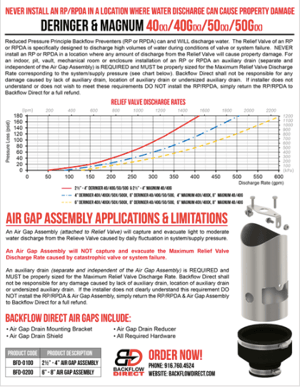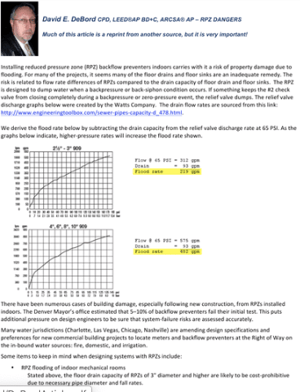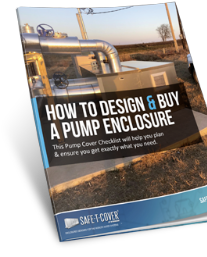Reduced Pressure Zone (RPZ) backflow preventers are designed to dump water to protect the public drinking water system. But most plumbing and mechanical engineers, building owners and property insurers are unaware of the potential flood risk created when the RPZ valve is installed inside. One backflow manufacturer has published information that designers and building owners should consider. Here are three things this manufacturer wants to make known about RPZ flood risks.
Worst Location For An RPZ Backflow Preventer
Notice the headline on the RPZ Relief Valve Discharge Rate: NEVER INSTALL AN RP/RPDA IN A LOCATION WHERE WATER CAN CAUSE PROPERTY DAMAGE.

If we stop and think about an RPZ installed inside a building, where might it be installed where property damage is not a possibility? There may be instances, but most RPZ valves are installed in locations where it is apparent the flood risk has not been considered. Here’s a case study where the building owner learned about the flood risk.
Return The Valve For a Refund
Send the valve back for a full refund – this manufacturer does not want the valve installed inside the building unless the auxiliary drain is in place to account for the possibility of a high volume of water discharge. So much so that a full refund will be provided if the valve is returned. Seems like they know something they want everyone else to know, too.
Auxiliary Drains Are Required
This manufacturer indicates AN AUXILIARY DRAIN IS REQUIRED. All RPZ valve manufacturers publish discharge rates for the relief valve. The relief valve is designed to discharge high volumes of water during conditions of valve and system failure. In the top paragraph, notice the manufacturer indicates they shall not be responsible for any damage caused by a lack of an auxiliary drain.
In other words, the responsibility for any damage caused by the RPZ valve discharging is being shifted away from them. Now, who is holding the bag? If this manufacturer had no concern about flood risk, why would they make this statement? The risk is real. During a Safe-T-Cover presentation to a large mechanical and plumbing design/build firm in Chicago, someone announced, “These things don’t flood. I don’t know why these scare tactics are being used to persuade design.” No sooner than this designer finished the remark, another person spoke up and said, “Oh, yes they do. Remember when our building flooded a few years ago? It was from an RPZ relief valve discharge.” The room was quiet.
An auxiliary drain is cost-prohibitive. David Debord, FASPE, indicates floor drain capabilities for RPZs 3” diameter and higher are likely to be cost-prohibitive due to necessary pipe diameters and fall rates. Read more about what David says in this article.

Don’t take this risk
If you are an architect, design engineer or building owner, consider the risk of installing RPZ valves inside the building. Backflow device companies provide flood protection, shutdown valves and relief valve discharge rates because they know the discharge from a relief valve can cause catastrophic flooding.
If a building floods and your client’s insurance company starts looking for the cause, you could be the person selected as the one responsible for the flood. Do you want to be held accountable for the damage caused by an RPZ? Probably not! Our work with engineers and architects over the last five years tell us most are simply unaware of the flood risks. As an informed designer, you can explain the flood risks to your client and provide them with options. Will your owner choose to take the risk or move the RPZ outside the building on your next project?
Over the last several years, municipalities and water purveyors have been evolving their standards for backflow prevention valves on commercial facilities.
Our illustrated guide, “Trends in Backflow Prevention” covers key topics including: water supply safety, types of backflow, and types of valves. It’s a great resource for engineers and executives responsible for commercial water supply and infrastructure.





